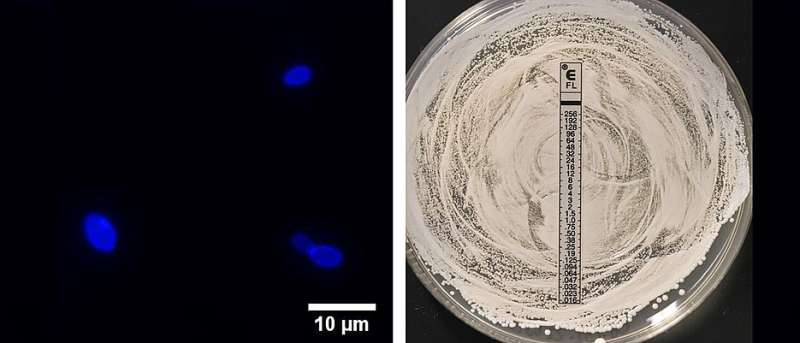
Among the yeasts from the Candida genus that cause infections in humans, the species Candida auris is still relatively new: this species was only described in 2009, and to date no evidence has been found before the 1990s. It is unclear what ecological niche C. auris colonizes and why human infections have increased since around the turn of the millennium.
Treatment of C. auris infections is greatly complicated by the pathogen’s potential to develop resistance to all available antifungal classes. In addition, unlike other Candida species, C. auris can be efficiently transmitted from patient to patient via direct and indirect contact, leading to hospital outbreaks that are difficult to control.
Dramatic increase in the U.S.
Such outbreaks have now been observed worldwide, including in England, Spain and Italy. In April 2023, a dramatic increase in C. auris infections was shown for the U.S., along with further resistance development. A recent analysis by the European Centre for Disease Prevention and Control also shows a significant increase in case numbers for Europe.
As a result, the U.S. Centers for Disease Control classify C. auris as an “urgent threat”—the highest prioritization category within multidrug-resistant pathogens. In the 2023 list published by the World Health Organization for prioritizing fungi that cause human infections, C. auris is also grouped as one of only four pathogens in the highest priority level.
Increase in case numbers in Germany
In Germany, there have only been isolated cases in which C. auris has been detected since 2015. However, an analysis now published in the Deutsches Ärzteblatt shows that the number of cases has also increased in Germany in recent years.
Responsible for this study were Dr. Alexander Aldejohann from the Institute for Hygiene and Microbiology at the Julius-Maximilians-Universität Würzburg (JMU) and scientists from the National Reference Center for Invasive Fungal Infections (NRZMyk) and the Robert Koch Institute. Also involved was Professor Oliver Kurzai, Director of the Institute of Hygiene and Microbiology and Head of the NRZMyk.
The study is based on a comparison of C. auris data from the NRZMyk and the antibiotic resistance surveillance network of the Robert Koch Institute. A total of 43 C. auris cases were recorded in the two databases by the end of 2022. Colonization was detected in 19 cases and infection requiring therapy in 16 cases. In almost 42 percent of the cases, a stay abroad was documented shortly before the detection of infection.
Resistant to common drugs
80 percent of the fungal strains available at NRZMyk were highly resistant to fluconazole, a commonly used antifungal agent. In one case, there was resistance to echinocandin, a comparatively new class of substances for the treatment of fungal infections. The data analysis also recorded probable nosocomial transmissions in Germany for 2021 and 2022—i.e. infections contracted by patients in connection with a medical procedure, for example in hospitals, care facilities or outpatient practices.
In summary, the authors conclude that the absolute number of C. auris infections in Germany remains low. However, the significant increase in the number of infections during the past two years and the detection of the first transmission events in Germany should, in their opinion, be interpreted as an alarm signal.
“Compared to other European countries such as Spain, Italy or Great Britain, the case numbers in our country are fortunately still low. We must do everything we can to keep it that way for as long as possible—our experience shows that any infection with Candida auris is difficult to treat and potentially life-threatening for patients. However, the good news at the moment is that no patient in a German hospital has to be afraid of becoming infected with Candida auris,” says Dr. A. Aldejohann, Specialist in Microbiology, Virology and Infectious Disease Epidemiology, Institute of Hygiene and Microbiology, University of Würzburg.
“Our analyses show—fortunately still at a very low level—a significant increase in C. auris imports into Germany. At the same time, we were able to prove that the cases are currently not completely recorded in any database—we have to assume an unreported number. In view of the fact that we are also already finding the first transmission events in Germany, I have recommended to the Robert Koch Institute the introduction of a statutory laboratory reporting requirement for the detection of C. auris. In my view, this can be implemented with reasonable effort and, in addition to a precise recording of the epidemiology, would also make it possible to initiate infection protection measures at an early stage in the event of detection,” says Dr. Oliver Kurzai, Chair of Medical Microbiology and Mycology, University of Würzburg.
The findings are published in the journal Deutsches Ärzteblatt international.
Franziska Pietsch, Julius-Maximilians-Universität Würzburg

